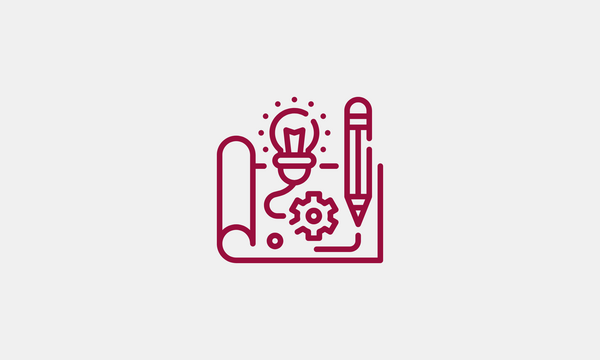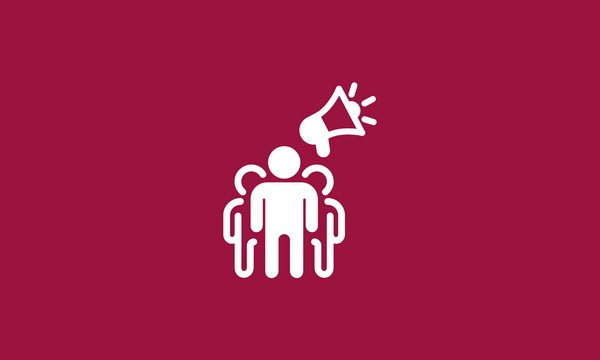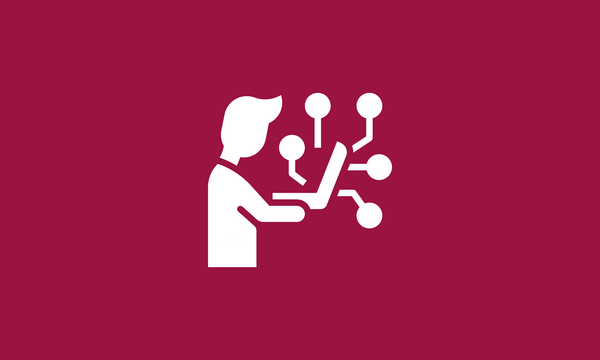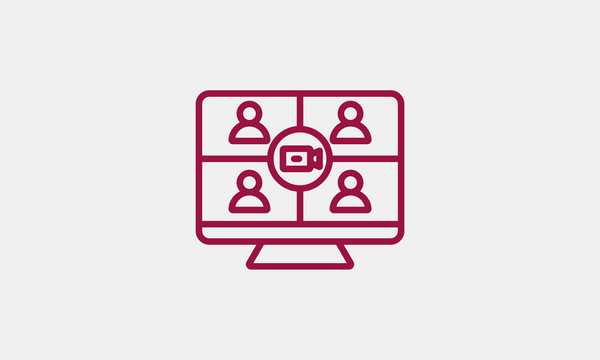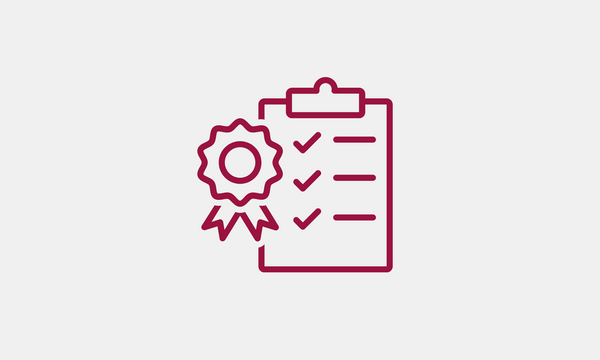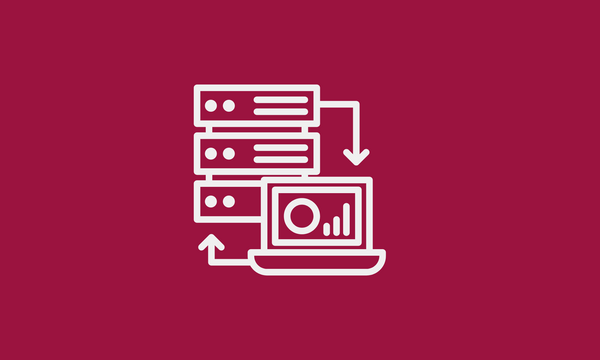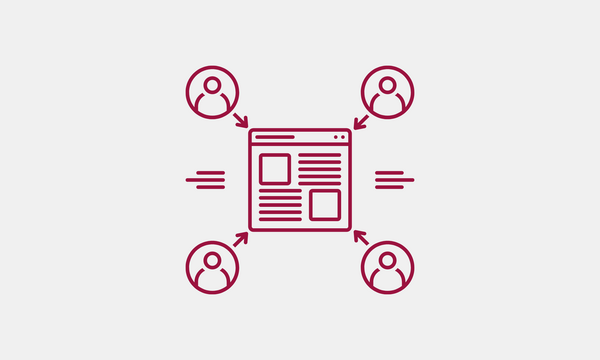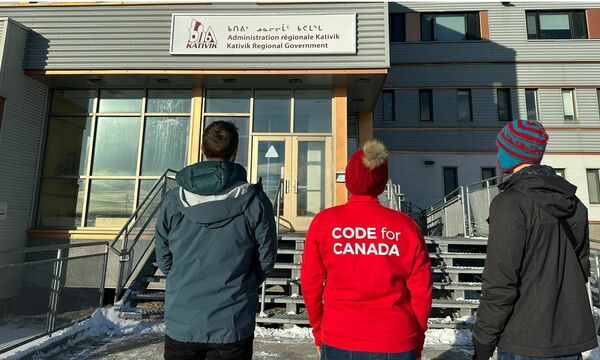Introducing MOVE: a centralized platform for traffic volume and collision data

Maddy Ewins
February 16, 2021
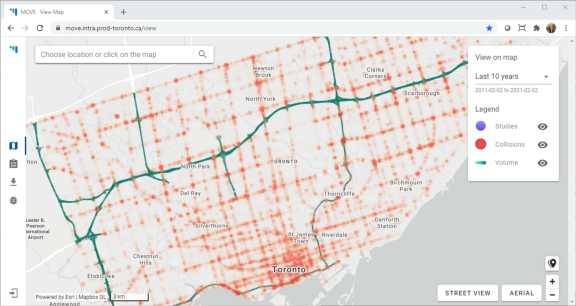
The Code for Canada fellowship program is no longer active. To learn more, visit our fellowship yearbook.
Two years ago, a group of three Code for Canada fellows embarked on a 10-month journey to improve access to data that informs road safety initiatives in Toronto.
Our very own Barbara Gray, General Manager of the City of Toronto’s Transportation Services division, summarizes the challenge best.
Many hours of user research, prototypes, iterations, and usability tests later — MOVE is finally here! We launched in December 2020 (read more about our process getting there).
If you’re thinking “okay, that’s cool… but what even is MOVE?” you’ve come to the right place.
Imagine you’re a resident of Toronto. You live in a quiet neighbourhood that backs onto a busy major road. Every morning, you walk your child to the local elementary school. To do this, you have to cross the busy road.
Unfortunately, the nearest major intersection — which has traffic lights and a pedestrian crossing signal — is a few blocks over, and adds five minutes to your walk. You notice other people risk running across the road when there’s a gap in the flow of traffic. Frustrated and concerned about pedestrian safety, you call the city and ask if they will install a crosswalk.
At this point, city staff begin to investigate. Traffic Operations investigators — these are engineers, experts in the design of transportation infrastructure — assess the area. Let’s say the investigator on the case is named Terry. Terry will look at the road, the surroundings, any available data about past collisions, traffic volumes, and other information needed to make a formal assessment. Investigators focus on safety, while considering the needs of all the road users — pedestrians, cyclists, and motorists alike. Finally, Terry will make a decision on whether a pedestrian crosswalk is warranted here, and if it’s not, provide an explanation for why.
City staff receive requests like this from 311 and through city councillors. There are other teams at Transportation Services dedicated to assessing the holistic needs of a neighbourhood, and making streets safer and more efficient for all; and other teams that address high-risk intersections or stretches of road, and look at ways we can change the street design to eliminate preventable fatalities and serious injuries altogether (that’s part of Toronto’s Vision Zero plan).
Regardless of where the need comes from, investigators and teams rely on data to inform their investigations and recommendations.
What’s the problem?
Staff rely on two core datasets:
- Traffic volume data — vehicle, cyclist, and pedestrian volumes and speeds
- Collision data — where collisions have happened, their severity, and other details about the collision
Staff access these datasets through two tools: CRASH for collision data, and FLOW for traffic volume data. These tools were built in the 1990s, and they were a huge improvement at the time! But they have outlived their useful shelf life.
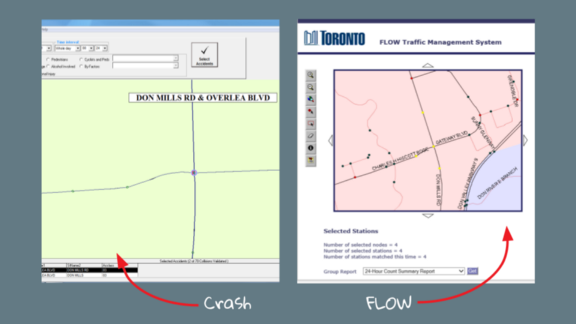
While these legacy systems are still operational, the City of Toronto’s mobility and transportation needs have changed a lot in the past 20–30 years. In 2015, the city committed to Vision Zero: “fatalities and serious injuries on our roads are preventable, and we must strive to reduce traffic-related deaths and injuries to ZERO.”
There’s also been shift in transportation communities to recognize that pedestrians and cyclists are road users, too. More emphasis needs to be placed on the access and safety of our transportation network for these users, as well as vehicles.
The legacy systems also haven’t kept up with the newer, modern tools of the computing age like the apps and websites we use daily, and the shift away from desktop computer applications towards web-based applications that allow staff to work on-the-go or from home.
MOVEing forward with new tools
Here’s where MOVE comes in. We’ve created a new tool where staff can access both traffic volume and collision data in one place.
A modern, map-based tool
One of the biggest improvements is a new, modern web tool (we don’t support Internet Explorer!). The existing tools can only be accessed through Internet Explorer and Windows 7 — both of which are being retired soon.
At a glance, staff can see collision hotspots (the dark orange/red areas on the map) and a rough estimate of traffic volumes (the teal lines on the map).
The experience of using MOVE is like using Google Maps. You can zoom and pan with your mouse or a trackpad. This sounds basic, but this is a major upgrade from the legacy tools! Here's what it looks like in action.
You can toggle layers on and off to get a more detailed view of the geospatial data.

The search bar allows staff to enter an intersection or a street name and suggests search results.
Finally, hovering over map features gives staff a quick peek at the data, without having to dive in and extract a whole PDF or CSV report.
Keeping all the data in one place
The legacy systems — CRASH and FLOW — are two separate applications. But many of the investigations performed by staff require both volume and collision data to give a complete picture of what’s happening at an intersection, or along a stretch of road.
How many vehicles, cyclists, and pedestrians move through this road? Which direction are they going? How many fatalities have previously happened here? Have any collisions had cyclists involved? School children? These are just a handful of questions investigators think about.
MOVE brings the data together in one view.
From this point, staff can drill down by using filters.
In this example, we’re narrowing down our results to collisions that occurred:
- On a weekday,
- Between the hours of 8:00am to 4:00pm,
- In the last five calendar years (between January 1, 2015 and December 31, 2020),
- Where the collision involved pedestrians or school children.
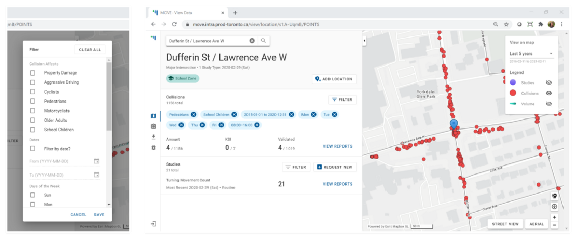
Once staff have filtered down to the data they need for an investigation, they can view and download reports for further analysis.
Making it easier to ask for new data
Sometimes, data is too old to use in an investigation. There’s already a process to get new data, but we’ve integrated the ability to request new data directly into MOVE. This will allow staff to have a better overview of the data requests.
So what?
Now, with MOVE, Terry the Traffic Operations investigator has a tool that is more usable, accessible and brings together collision and volume data. We’ve introduced powerful filtering with the representation of the data on the map throughout the entire experience. Behind the scenes, we’ve made sure data will be higher quality.
This is an amazing improvement. It’s intuitive and slick!
A new tool with higher quality data means more data-driven decisions.
It means less time spent on data retrieval, and more time spent on meaningful investigations into safety interventions.
You’ve done a really good job. MOVE is very functional and fast.
It means less flipping back and forth between different tools, which will reduce manual errors.
It means faster responses to 311 requests. It means that — if warranted — the pedestrian crosswalk in Terry’s investigation will be installed quicker, and maybe a life saved in the process.
A new tool also brings the possibility to integrate more kinds of data that hasn’t been part of the picture before.
Looking forward
Where will MOVE be in 6 months? 1 year? 5 years?
I can’t give you concrete answers, because one of our pillars of working is to be agile, respond to user feedback, and iterate on what’s working and change what isn’t. But I do know where we’re going.
We haven’t just given a facelift to old tools. In creating this new system, we’ve created a foundation that is more flexible, inviting, and useable. We can expand on this foundation by asking questions about the way data is used to drive decisions about safety and efficiency on Toronto’s streets.
- Can we take the data that already exists and display it in a more meaningful way?
- Can we empower staff along their journey of storytelling, and advocating for process change?
- What data is missing? How do we establish robust systems to collect new data?
With more data, and better quality data, imagine what’s possible.
- What if MOVE could suggest intersections where pedestrians, cyclists, and motorists are at high-risk of being involved in a collision?
- What if staff could intervene before a resident of Toronto was seriously injured?
- What if Terry, the Traffic Operations investigator, could identify the need for a crosswalk before a request is called in by a resident?

